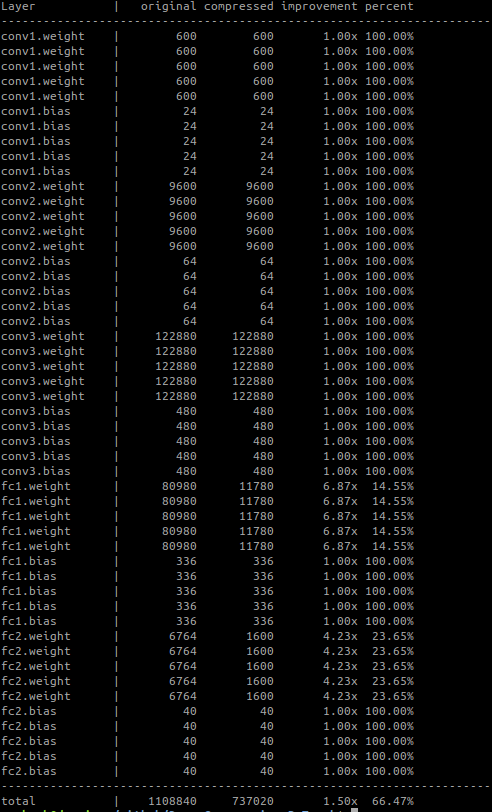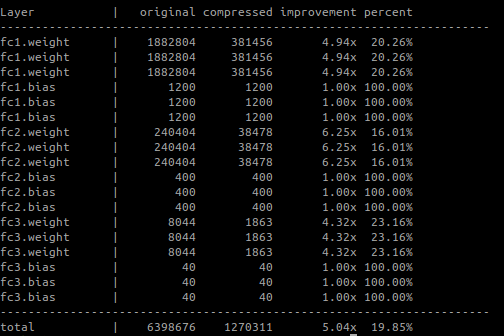Neural Network Compression
Main objective of this project is to explore ways to compress deep neural networks, so that the state of the art performance can be ahieved over a resource-constrained devices eg. embedded devices.
Recent research on deep neural networks has focused primarily on improving accuracy. For a given accuracy level, it is typically possible to identify multiple Neural Network architectures that achieve similar accuracy level. With equivalent accuracy, smaller architectures offer at least three advantages:
- Require less communication across servers during distributed training.
- Require less bandwidth to export a new model to client over the cloud.
- More feasible to deploy on FPGAs and other low power devices or low memory devices.
This reduction in model size is basically done by both using architectural changes and using techniques like Pruning, Huffman Coding and Weight sharing.
Following python packages are required:
- Python3.6+
- pytorch, torchvision
- numpy
- scikit-learn
- tqdm
- Visdom : sudo apt install visdom & pip install visdom (For ubuntu & Python 2.x)
In our approach we have tried We have started with these papers SqueezeNet and Deep Compression.
The main objective is to make changes in architecture to have model compression(reduction in number of parameters used) without significant loss in accuracy. Each convolutional layer will be replaced with a Fire Module. The basic block diagram of Fire Module is below:
The strategy behind using this Fire Module is to reduce the size of kernels. Fire module consists of two layers:
- Squeeze Layer
- Expand Layer\ In the figure explained above, squeeze layer have only 1x1 filters and Expand layer consists both 1x1 and 3x3 filters. So, there are three tunable parameters in this Fire Module, i.e sizes of 1x1 in squeeze layer and sizes of 1x1 and 3x3 in expand layer. The other two strategies used in Squeezenet are Decreasing the number channels and Downsampling later deep in the network to have larger activation maps.
- CIFAR10
- MNIST
- LeNet-5
- VGGNet
In the paper Deep Compression: Compressing Deep Neural Networks with Pruning, Trained Quantization and Huffman Coding, the authors have proposed a three-stage pipeline to reduce the storage requiments of deep neural networks:
- Pruning
- Quantization
- Huffman Encoding
- MINIST-6000 : The training set contains 60000 examples, and the test set 10000 examples.
Experiments were performed by applying the ideas of deep compression on following architechtures:
- LeNet-300-100
- LeNet-5
- VGG-19
-
MaxPool over AveragePool
-
Decrease in number of Feature Maps deep in the architecture
-
Number of Feature maps per layer depends upon the type of Dataset chosen
-
Fire modules should be implemented later in the Network
-
Replacing 5x5 with two 3x3 results slight drop in accuracy
SqueezeNet
- LeNet
| Type | Model Size | Accuracy |
|---|---|---|
| Original | 269KB | 99.07 |
| Squeezed Version | 72KB | 98.42 |
- VGG
| Type | Dataset | Model Size | Accuracy | Epochs |
|---|---|---|---|---|
| Original | MNIST | 79 MB | 97.85 | 20 |
| Squeezed Version | MNIST | 2.9MB | 99.6 | 20 |
| Original | CIFAR | 80.2 MB | 76.06 | 20 |
| Squeezed Version | CIFAR | 2.9MB | 62 | 20 |
| MNIST LeNET original | MNIST LeNET Squeezenet |
|---|---|
 |
 |
| MNIST VGG original | MNIST VGG Squeezenet |
|---|---|
 |
 |
| CIFAR VGG original | CIFAR VGG Squeezenet |
|---|---|
 |
 |
Deep Compression
- LeNet-5
- Pruning and retraining the network
- Pruning with threshold: 0.21358045935630798 for layer fc1
- Pruning with threshold: 0.25802576541900635 for layer fc2
| stages | Total | pruned | active | Compression Rate | percentage pruned | Accuracy |
|---|---|---|---|---|---|---|
| Before Pruning | 44426 | 0 | 44426 | 1x | 0% | 97.47% |
| After Pruning | 44426 | 10223 | 34023 | 1.3x | 23.01% | 98.40% |
- Weight Sharing Every non-zero weight is clustered in i.e 2^5 = 32 groups.
| stages | Avg. Loss | Accuracy |
|---|---|---|
| Before weight sharing | 0.0659 | 98.32% |
| After weight sharing | 0.0650 | 98.37% |
- Huffman Encoding
In this stage of pipeline we apply huffman encdoing algorithm to each weight in the network.
- LeNet-300-100
- Pruning and retraining the network
- Pruning with threshold : 0.23225528001785278 for layer fc1
- Pruning with threshold : 0.19299329817295074 for layer fc2
- Pruning with threshold : 0.21703356504440308 for layer fc3
| stages | Total | pruned | active | Compression Rate | percentage pruned | Accuracy |
|---|---|---|---|---|---|---|
| Before Pruning | 266610 | 0 | 266610 | 1x | 0% | 53.39% |
| After Pruning | 266610 | 253692 | 12918 | 20.64x | 95.15% | 96.54% |
- Weight Sharing Every non-zero weight is clustered in i.e 2^5 = 32 groups.
| stages | Avg. Loss | Accuracy |
|---|---|---|
| Before weight sharing | 0.1773 | 95.43% |
| After weight sharing | 0.1795 | 95.27% |
- Huffman Encoding
In this stage of pipeline we apply huffman encdoing algorithm to each weight in the network.
| Model | Initial Model Size | Compressed |
|---|---|---|
| LeNet-300-100 | 2.1 MB | 26.5 KB |
| LeNet-5 | 235 KB | ~200 KB (~3KB FC weight and biases) |
- For Huffman encoding: https://stackoverflow.com/questions/759707/efficient-way-of-storing-huffman-tree


